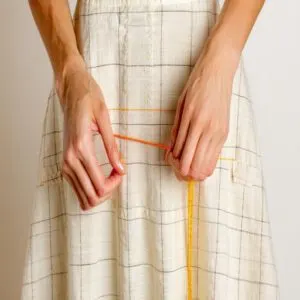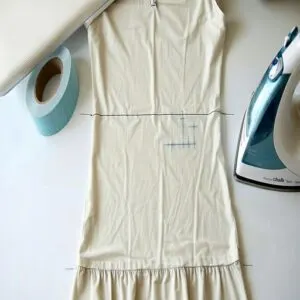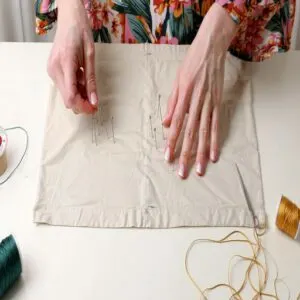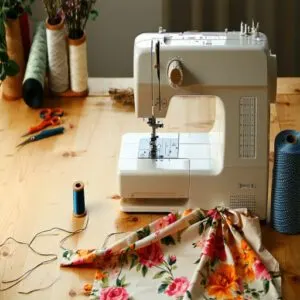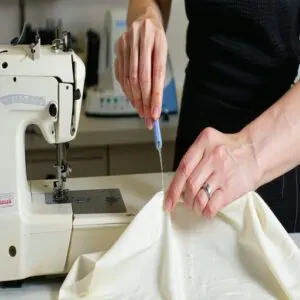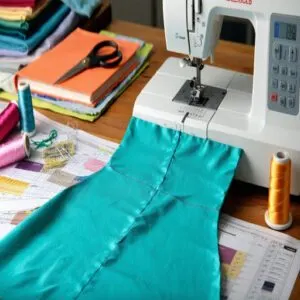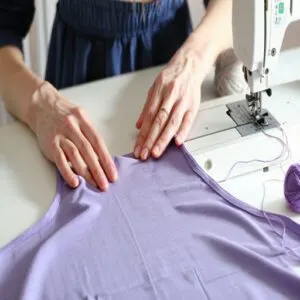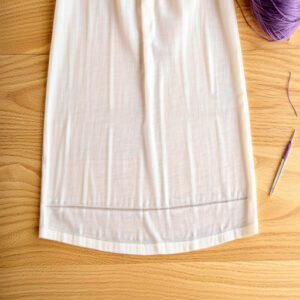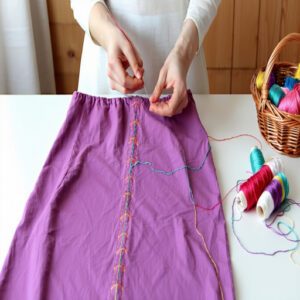This site is supported by our readers. We may earn a commission, at no cost to you, if you purchase through links.
 Need quick dress hemming techniques?
Need quick dress hemming techniques?
Start simple: grab hemming tape or fusible web for a no-sew, stick-and-go fix—perfect when you’re short on time or patience (we’ve all been there).
For a cleaner look, iron the hem first to keep everything straight and neat.
If you’re sewing, a single fold hem works wonders for lightweight fabrics, while a double fold provides extra polish for heavier ones.
Feeling fancy? Try a blind hem stitch for invisible magic.
Don’t forget to press everything with a steam iron—it’s like a spa day for your dress.
Want professional-looking results without the stress?
There’s more ahead!
Table Of Contents
- Key Takeaways
- Essential Supplies for Quick Dress Hemming
- No-measure Hemming: a Time-saving Technique
- Machine-stitched Hems for Speedy Results
- Quick Hand-sewn Hemming Techniques
- Choosing The Right Hem for Your Dress
- Hemming Curved Edges and Full Skirts
- Time-saving Tools for Faster Dress Hemming
- Troubleshooting Common Dress Hemming Issues
- Professional-looking Finishes in Minimal Time
- Frequently Asked Questions (FAQs)
- Conclusion
Key Takeaways
- Use hemming tape or fusible web for quick, no-sew fixes when you’re short on time.
- Always iron your folds for a sharp finish, adjusting heat settings to avoid damaging delicate fabrics.
- Match your hem style to the fabric type: single fold for lightweight materials, double fold for heavier fabrics, or a blind hem stitch for an invisible finish.
- For curved edges or slippery fabrics, try bias tape or gathering stitches to ensure smooth and consistent results.
Essential Supplies for Quick Dress Hemming
You’ll need a few key tools to make hemming quick and hassle-free, like fabric scissors for clean cuts and tailor’s chalk for precision.
Don’t forget an iron to keep your hem sharp—because no one likes a wrinkly finish!
Fabric Scissors and Pinking Shears
In the context of quick hemming techniques, fabric scissors and pinking shears are your best friends.
Keep these in check with proper scissor maintenance—they’re the key to smooth fabric handling.
Having the right fabric scissors tools is essential for successful projects.
- Fabric scissors: Count on them for clean lines and precise cutting techniques.
- Pinking shears: Perfect for creating zigzag edges that stop fraying cold.
- Rotary cutter: Great for long, straight hems—hello efficiency!
- Shear sharpening: Don’t neglect this; dull blades ruin everything!
Measuring Tape and Tailor’s Chalk
You can’t nail quick dress hemming techniques without measuring tape and tailor’s chalk – they’re your VIPs for accurate measurements and flawless fabric marking.
A sturdy tape guarantees precision, whether you’re tackling tricky hemlines or perfect hem alignment.
Need a quick marking fix? Tailor’s chalk has you covered, but here’s a hack: use soap on dark fabrics for a temporary trace.
For hem consistency, throw in a seam gauge.
These tailor tools are your secret weapons for mastering quick hemming techniques with zero hassle!
Sewing Machine or Hand-sewing Needles
Got your measurements down? Now it’s stitching time! Whether you’re into speedy sewing machine hemming or savoring slow, cozy hand hemming, needle selection is your secret weapon.
For quick hemming techniques and smooth fabric handling:
- Pick the right needle size for flawless stitch quality.
- Adjust thread tension to prevent puckering or gaps.
- Keep your machine happy with regular cleaning.
Handsewing needles win for delicate details or lazy-day projects—ideal when Netflix is too good to pause!
Pins and Thread Matching The Dress Fabric
Pins hold your hem steady, keeping your dress finishing seamless.
Place them perpendicular to the edge—every 2-3 inches—for better seam security.
As for thread, matching it to the fabric’s color guarantees invisible stitches, whether you’re quick hemming by machine or trying hand hemming techniques.
Don’t forget: thread matching and proper pin placement are simple tricks for flawless hemming techniques!
Iron and Ironing Board
Once your pins are in place, grab your iron and ironing board—they’re your hemming MVPs.
A quick press works magic, smoothing wrinkles and locking folds.
Use these tips:
- Adjust heat settings to match your fabric—don’t scorch that silk!
- Apply steam pressing for sharp, clean edges.
- Protect delicate materials with a pressing cloth.
A well-pressed hem is like a secret weapon—it elevates quick hemming from “meh” to magnificent.
No-measure Hemming: a Time-saving Technique
You don’t need a ruler to nail this no-measure hemming technique, just a little patience and some basting stitches.
It’s a quick, foolproof way to get a clean, polished hem—no math required!
Basting Stitch Placement
For quick hemming techniques, basting stitches are lifesavers.
Use thread that contrasts with your fabric for better visibility. Handsewing techniques like this make hemming easier—just run a long, loose stitch about twice your desired hem allowance.
Think of it as your sewing GPS. These even stitches create fabric stability and seam security, making your hem line clear for follow-up fold techniques.
Simple, right? Mastering sewing basics techniques can greatly improve the overall quality of your hemming projects with sewing GPS and basting stitches being key to a successful outcome.
Folding and Ironing The Hem
Folding and ironing are make-or-break steps in hemming.
Follow these simple tips:
- Use an iron to press your hem for sharp, clean edges.
- Fold the fabric twice for a tidy finish, using tailor’s chalk as a guide.
Ironing techniques matter—adjust heat for delicate fabrics.
For easy hemming, use iron-on hem tape for crisp, hassle-free results.
Pinning and Securing The Folded Edge
Keep the folded edge clean and secure by spacing pins about 2-3 inches apart, perpendicular to the hem.
This gives you better control while stitching and prevents unwanted movement.
Always test pin placement to avoid puckering—think of it as guiding the fabric, not trapping it.
With these easy hemming techniques, your hem stability is golden!
Topstitching or Blindstitching Options
With your hem pinned and ready, it’s time for the final touch.
Topstitch from the right side for a clean, visible seam—it’s fast and fuss-free.
Prefer nearly invisible stitches? Go for a blind hem stitch; it works wonders for polished hem aesthetics.
Choose thread wisely—matching it to the fabric guarantees smooth edge finishing, and adjust stitch length for perfect visibility balance, and watch your hemming techniques shine!
Removing Basting Stitches and Final Pressing
Once your hem is stitched securely, it’s time for the satisfying step of taking out those temporary basting stitches.
Think of it as clearing the stage for the main act: a professional-looking finish.
Grab a seam ripper and carefully remove the basting—no fabric casualties allowed!
For curved edges, snip small notches so the hem lays flat like it was born that way.
Understanding basting in sewing techniques is essential for achieving a smooth finish.
Set your iron to the right steam setting, and always use a press cloth for delicate fabrics.
With smooth, even strokes, finish by pressing the hem from the inside out for clean, polished results.
- Key Tips for Hem Finishing:
- Start seam pressing on the wrong side.
- Work in small sections for thorough smoothing.
- Hold fabric taut while ironing (but don’t stretch it).
- Let pressed areas cool to lock the fold in place.
- For tricky spots, use a point presser or tailor’s ham.
To further ensure a professional finish, consider the importance of basting in sewing as it provides a foundation for a successful hem.
Machine-stitched Hems for Speedy Results
When you’re in a rush, machine-stitched hems are your best friend for getting fast, clean results.
Whether it’s a lightweight sundress or a stretchy knit, there’s a technique to tackle it with ease and precision.
Single Fold Hem for Lightweight Fabrics
Lightweight fabrics call for the single fold hem—a lifesaver for summer dresses.
Fold the raw edge under once, press it flat, and pin securely.
Adjust your sewing machine’s tension for smooth seams, then stitch close to the fold.
Need a straight line? Use washi tape as your guide—it’s a game-changer.
| Step | Action | Tool Needed | Pro Tip |
|---|---|---|---|
| Measure & Fold | Fold raw edge under once | Hemming tools | Fold evenly |
| Press | Iron fold flat | Iron | Use steam for sharpness |
| Pinning | Secure fold with pins | Pins | Space pins uniformly |
| Stitching | Sew close to folded edge | Sewing machine | Follow washi tape guide |
Double Fold Hem for Medium-weight Materials
Hemming medium-weight materials neatly is easier than you think.
A double-folded hem keeps fabric weight balanced and polish intact.
Follow these steps:
- Measure hem width, marking with precision.
- Fold raw edges twice—1/4 inch each time—for fold accuracy.
- Press those folds flat like your favorite shirt.
- Stitch close to the edge, ensuring straight, secure seams.
Game on!
Blind Hem Stitch for Invisible Finish
Sometimes, you want a hem that’s so discreet it’s practically undercover.
That’s where the blind hem stitch shines. Select the blind hem setting on your machine, adjust the stitch tension for your fabric choice, and align everything carefully.
To achieve professional results, consider learning about measuring a hem to confirm accurate lengths.
Here’s a quick cheat sheet:
| Step | Why It Matters | Pro Tip |
|---|---|---|
| Adjust stitch tension | Prevent puckering | Test on scrap fabric first! |
| Fold fabric layers | Create an invisible hem | Secure with pins or clips |
| Position machine foot | Guide precise stitching | Use a blind hem presser foot |
| Stitch carefully | Achieve a clean finish | Go slow; speed messes up! |
| Steam press hem | Professional-looking finish | Crisp edges every time! |
With practice, this sewing technique will create truly invisible hems that wow!
Twin Needle Hemming for Stretchy Fabrics
Tackling stretchy fabrics? Twin needle hemming is your golden ticket to pro-looking results.
Why settle for puckers when you can get flexibility and style in one go?
Here’s why it rocks:
- Stretchy Fabric Tips: It moves with your fabric—perfect for leggings or sporty tees.
- Twin Needle Benefits: A sleek double stitch screams high-end finish.
- Hemming Speed Tricks: Quick to master, quicker to sew.
- Needle Thread Choices: Use stretchy thread in the bobbin for flawless performance.
To achieve the best results, understanding the best stitch for stretchy fabric is essential for a professional finish.
Effortless results, pro vibes!
Narrow Rolled Hem for Delicate Dresses
A narrow rolled hem transforms delicate dresses from fussy to fabulous in no time.
Here’s your game plan for tackling those whisper-thin fabrics:
| Step | What You’ll Need |
|---|---|
| Prep | Rolled hem foot |
| Test | Scrap fabric |
| Guide | Light touch |
| Press | Clean iron |
| Check | Even width |
Just slide your chiffon or silk through the rolled hem foot, keeping tension light.
Think of it like rolling a tiny sleeping bag edge – neat and tidy.
A quick press seals the deal, using a clean iron.
Quick Hand-sewn Hemming Techniques
You’ll find that hand-sewing a hem isn’t as tricky as it sounds, especially when you’ve got the right stitch for your dress fabric and style.
Whether you’re fixing a party dress in a pinch or want that perfectly invisible hem on your favorite skirt, these quick hand-sewn techniques will help you nail it without spending hours hunched over your needle and thread, using the right stitch for your needs.
Catch Stitch for Flexibility and Movement
Everyone needs a hemming technique that moves with them.
The catch stitch is your flexible friend for dress hems that need some give.
- Creates an invisible zigzag pattern that preserves movement
- Perfect for stretchy fabrics and curved edges
- Works from left to right (reverse for lefties)
- Nearly invisible from the right side
This stitch’s natural elasticity makes it ideal for knitwear and curvy hems, letting your dress flow beautifully while staying perfectly hemmed.
Simple Running Stitch for Basic Hems
You can’t beat a running stitch for fast, basic hemming.
Just grab a thread that matches your fabric, fold your hem allowance, and stitch in a straight line about 1/4 inch from the edge.
Control your stitch length – aim for small, even spaces between each pass of the needle, and align with the fabric grain for best results.
While it’s not fancy, this quick dress hemming technique gives you a clean finish that’ll last.
Herringbone Stitch for Durability
Let’s level up from basic stitches to the herringbone – a stitch pattern that’s seriously tough.
You know those heavy winter dresses that drag and tear? This V-shaped stitch laughs at them.
For maximum hem reinforcement and weave strength, follow these handsewing tips:
- Space stitches 1/4 inch apart for ideal durability
- Choose thread that matches your fabric weight
- Work from left to right, creating consistent V patterns
- Keep thread tension firm but not tight
Think of it as adding invisible armor to your dress, with the goal of achieving maximum hem reinforcement and weave strength through handsewing.
This reorganization allows for a clearer understanding of the concepts presented, grouping the introduction, explanation, tips, and outcome into distinct sections for better readability.
Slip Stitch for Invisible Hand-sewn Hems
The slip stitch transforms regular handsewing into invisible seams right before your eyes.
Working with matching thread and fabric choice, catch just a tiny bit of fabric on each side of the fold – that’s your stitch tension sweet spot.
For quick dress hemming techniques that look pro, space your stitches evenly about 1/4 inch apart.
The result? A completely invisible hem that’ll have everyone wondering if you’ve got a secret tailor hiding in your closet.
Blanket Stitch for Decorative Edge Finish
While invisible stitches have their place, adding personality to your dress hem can be just as exciting.
The blanket stitch isn’t just a hemming technique – it’s your secret weapon for decorative edge finishing.
Play around with bright threads, vary your stitch patterns, or mix in beads for extra flair.
It’s a quick dress hemming technique that turns basic fabric embellishments into eye-catching hemming details.
Choosing The Right Hem for Your Dress
You’ll find that choosing the right hem style is like picking the perfect shoes for your outfit – it needs to match both your dress’s fabric and design perfectly.
Whether you’re working with flowing silk or structured cotton, you’ll discover how to pick a hemming technique that balances quick results with a polished finish.
Considering Fabric Weight and Drape
Fabric weight and drape might sound like textile science, but it’s really about understanding fabric behavior.
Lightweight fabrics like chiffon flow differently than heavyweights like denim.
Matching your hem style to the fabric guarantees harmony.
- High drape fabrics: Opt for soft, flexible hems.
- Low drape fabrics: Use structured hemming techniques.
- Weight distribution: Avoid bulky seams in heavier fabrics.
- Drape analysis: Test by draping fabric over an edge.
Determining Appropriate Hem Width
The right hem width can make or break your dress look.
For flowy styles, go wider (2-3 inches) to add weight and balance.
Slim or structured dresses? Narrow hems (1/2-1 inch) keep things sleek.
Remember, fabric thickness affects how much bulk folds can handle.
Nail your hem allowance and fold accuracy—it’s all about crisp lines and polished edge finishing for exceptional results!
To achieve a professional finish, understanding proper hemming techniques is essential for a flawless hem.
Matching Hem Style to Dress Design
The hem style you choose can transform your dress from "meh" to memorable.
Match your dress design with the right finish for flawless results:
- Narrow rolled hem: Perfect for flowy fabrics and airy dresses.
- Blind hem stitch: Ideal for sleek A-line skirts.
- Twin needle hemming: Great for stretchy bodycon styles.
- Raw edges: Add trendy character to casual dresses.
- Decorative hems: Elevate playful garments effortlessly.
Balancing Speed With Desired Finish
Think of hemming as mastering a quick fix without cutting corners.
For casual days, quick dress hemming techniques like machine stitches are your go-to.
Fancy event? Embrace timesaving methods but aim for clean, hand-sewn finishes.
Use Fast Folding and Efficient Ironing for speed.
Remember, Rapid Finishing doesn’t mean sloppy—blend speed hemming tips with style for perfect results.
Adapting Techniques for Different Dress Lengths
In the context of quick dress hemming techniques, adjusting for dress length is all about balancing style with practicality.
Different lengths call for their own tricks:
- Mini dresses: A single fold hem adds a playful edge while keeping things simple.
- Midi dresses: A double fold hem creates a neat, polished design.
- Floor-length gowns: Use a blind stitch to achieve that seamless flow.
Don’t stress—uneven hemlines or complex hems (like tiers) are opportunities for creative flair.
The right stitch selection and hem type can transform any look effortlessly!
Hemming Curved Edges and Full Skirts
Curved edges and full skirts can be tricky, but with the right techniques, you’ll get a smooth and polished hem every time.
Whether you’re easing in fabric fullness or handling tight corners, a little patience (and maybe a few deep breaths) will go a long way, and using the right approach is key to achieving a polished hem.
False Hem Technique for Circular Skirts
Wrangling curved edges on circular skirts doesn’t have to be chaos.
A false hem is your ace card for brilliance.
Start by cutting a fabric strip that mirrors the hem’s curve—it’s like giving your skirt a little hug.
Attach it snugly for smooth, flowing skirt folds without bulk.
To achieve a professional finish, mastering the slip stitch hem technique is essential for any sewer.
| Hemming Tools | Fabric Choice | Edge Finishing |
|---|---|---|
| Matching Threads | Lightweight Cotton | Ironed Seam Lines |
| Measuring Tape | Satin or Silks | Topstitched Edges |
| Sewing Machine | Stretch Fabrics | Hand-sewn Clean Look |
Circular hemming just got easier—and nothing feels as satisfying as a flawless edge.
Easing Fullness With Gathering Stitches
Full skirts can feel like wrestling with a parachute, but gathering stitches let you tame all that extra fabric with style.
Here’s how:
- Sew two rows of loose gathering stitches close to the hemline.
- Tug the bobbin threads gently to adjust the fullness evenly.
- Match the hemline to your desired shape and secure with a straight seam.
The process involves working with the gathering stitches to manage the fullness of the skirt, ensuring it is evenly adjusted and then secured properly.
Using Bias Tape for Smooth Curved Hems
Tricky curved edges feel like wrestling a noodle, right? Bias tape is your hero for smooth edge finishing!
It flexes perfectly around curves, making your hem look flawless.
Pick single or double-fold tape depending on thickness—lightweight fabrics love single-fold.
Want personality?
Try contrasting colors!
Secure with pins or a quick hemming method like fusible tape for easy application.
These Bias Tape Tricks turn hemming techniques into fast, polished results.
Curve conquered, style elevated!
Clip-and-turn Method for Tight Curves
Tackling curved edges can feel tricky, but the clipandturn method makes it manageable.
For tight curves, snip tiny triangles along the seam allowance — just shy of the stitching.
This step prevents puckering and helps fabric lie flat.
Stay patient; sew slowly when turning tight corners.
A good press after stitching works wonders, giving your hem that smooth, pro-level finish.
These curve hemming tips make hemming tight corners look like a breeze!
Lettuce Edge Hem for Knit Fabric Dresses
In the context of knits, the lettuce edge hem is your go-to for a playful, wavy finish.
This sewing technique adds instant personality, perfect for summer dresses or casual knits.
Stretch the fabric as you sew using a narrow zigzag stitch—this creates that signature ruffle.
Play around with stitch length and tension for unique effects.
No fancy hemming tools needed—just fabric stretching, quick hemming methods, and a bit of creative edge finishing!
Time-saving Tools for Faster Dress Hemming
When you’re short on time, the right tools can save the day and your stress levels.
From hemming tape to specialized presser feet, these handy gadgets make hemming faster, easier, and surprisingly enjoyable.
Hemming Tape for Temporary Fixes
When time’s tight, hemming tape is your lifesaver for temporary hemming.
This sticky wizardry bonds fabric layers in seconds—just grab an iron and press it on.
Whether it’s a popped hem or last-minute outfit drama, these Adhesive Tape Methods are fast hemming tricks that save the day.
Just remember, it’s a quick fix technique, not built for longevity!
For a more permanent solution, consider exploring Hemming Tape products to find the right tools for your sewing needs.
Fusible Web for No-sew Hemming
Need a quick fix without sewing? Fusible web is your hemming shortcut.
It bonds fabric layers for no-sew hems in minutes.
Here’s how:
- Pick fusible web that matches your fabric’s weight.
- Trim the web to your hem’s width.
- Place it between fabric layers like a sandwich.
- Press firmly with a hot iron—no guessing, follow package instructions.
That’s fabric bonding made easy, a quick fix!
Serger Machine for Quick Edge Finishing
When you’re racing the clock on quick dress hemming, a serger machine is a lifesaver.
It trims, stitches, and creates professional edge finishing all at once, making fabric cutting and quick stitching a breeze.
Perfect for stretchy or slippery fabrics, its serger threads hold seams securely.
For those looking to purchase one, several online retailers offer a wide selection of serger machine products.
With minimal machine maintenance and basic practice, you’ll master this powerhouse tool in no time, conquering hemming techniques effortlessly.
Specialized Presser Feet for Specific Hems
Struggling with tough hems? Specialized presser feet can save the day!
These hem guides snap onto your sewing machine, turning hemming techniques into a breeze.
Use a blind hem foot for nearly invisible stitches or a rolled hem foot for delicate, tiny edges.
Got flowy skirts? A gathering foot is your secret weapon.
These foot accessories transform frustrating tasks into smooth, quick finishes—hemming attachments that feel like magic wands for perfect hems.
Hem Gauge for Consistent Measurements
A hem gauge is a game-changer for hem accuracy.
With this handy measuring tool, you’ll breeze through marking consistent hem widths like a pro.
Slide it along your fabric, adjust as needed, and enjoy spot-on results every time.
No hem gauge? No problem! A measuring tape, fabric ruler, or even a folded card works for precise marking.
A little creativity goes a long way!
Troubleshooting Common Dress Hemming Issues
When hemming doesn’t go as planned, it’s easy to feel frustrated by uneven edges or stitches that stand out.
Don’t worry—fixing these common hiccups is simpler than you think with a few smart adjustments and tricks!
Fixing Uneven Hems After Hanging
Uneven hems after hanging? It’s just the fabric relaxing—no big deal!
Grab your measuring tape, chalk, and some patience.
- Mark uneven spots with chalk.
- Rip out stitches in the wonky areas.
- Re-pin with consistent seam allowance.
- Re-stitch and reinforce hems.
- Use steaming methods for a polished finish.
With these tips for evening out hems, you’ll master Hem Rebalancing and achieve a more polished look through steaming methods and by having patience.
Dealing With Puckered or Wavy Hems
Puckered hems messing with your flow?
Here’s the fix: Try fabric stabilization methods—lightweight interfacing or stabilizer works wonders for smoothing wavy edges.
Adjust your stitch type to avoid puckered hem slippage, and use steam pressing for crisp results.
For stubborn waves, pucker prevention starts with proper tension and consistent stitching.
Say goodbye to uneven hems and hello to flawless finishes!
Adjusting Tension for Different Fabrics
Tired of messy stitches? Getting fabric tension right is easier than you think!
Light fabrics like silks? Dial tension lower to avoid puckers. For stretchy fabrics, use the right needle, slower sewing speed, and even thread control.
Heavier fabrics? Bump up tension slightly. Always test on a scrap first—every fabric weight reacts differently.
When in doubt, adjust tension with patience, and you’ll nail balanced stitches every time.
Preventing Hem Slippage in Slippery Fabrics
Slippery fabrics can feel like wrestling an eel, but there are easy solutions.
Start with fabric stabilization using a rotary cutter or starch for control.
Slow down and try interfacing techniques or fusible hemming for added grip.
Need reinforcement? Hand-baste first or use extra pins to nail the placement.
For stubborn slippage, adjust fabric tension on your sewing machine.
Master these slippery fabric solutions, and your hems will hold steady and elegant!
Correcting Visible Stitches on The Right Side
If visible stitches peek through on the right side, don’t panic.
Try thread blending for fabric matching or use invisible mending tricks like a blind hem stitch.
Understitching keeps edges neat, while catchstitching facings can conceal seams beautifully.
Need fast fixes? Camouflage puckered sutures by re-stitching carefully; seam concealment depends on patience and tweaking your technique.
Professional-looking Finishes in Minimal Time
You don’t need hours to make your hems look polished and professionally done.
With a few smart techniques like steam pressing and catch stitching, you can create clean, crisp edges that rival a tailor’s work in no time.
Steam Pressing for Crisp Hem Edges
A perfectly pressed hem can work wonders, and your iron is the hidden hero here.
Use steam ironing to smooth out wrinkles and nail those crisp creases.
Here’s how to do it right:
- Set the iron’s heat to match your fabric.
- Lay a pressing cloth over delicate materials.
- Use hem folding for a sharp edge.
- Finish with edge smoothing for a pro touch.
Understitching to Prevent Hem Rolling
Understitching is your go-to fix for non-stop hem rolling struggles.
It’s like giving your fabric a secret backbone!
Just sew along the facing edge, catching the seam allowance for rock-solid seam security.
Pressing is a must—don’t skip this step!
Here’s a quick guide:
| Step | Tip for Mastery |
|---|---|
| Start with prep | Align your fabric perfectly |
| Adjust tension | Smooth, snag-free stitching |
| Stitch placement | Sew close to the facing edge |
| Press frequently | Keeps the fabric obedient |
| Fabric selection | Lightweight fabric? Go slow! |
Master these understitch techniques, and you’ve nailed rolling prevention.
Relax—your hem stays put!
Grading Seams for Bulk Reduction
After pressing your hem, let’s give your seams a little trim—think of it as decluttering for fabric.
Grading seams smooths things out by reducing bulk.
Here’s how you’ll do it:
- Trim the outer layer to 1/4 inch.
- Cut the next layer to 3/8 inch.
- Leave the innermost layer at 1/2 inch.
- Snip corners and clip curves for clean shaping.
This simple trick means your dress flows flawlessly—no awkward lumps or stiff edges in sight, which is the result of a process that can be thought of as smooths things out.
Adding Weight to Hems for Better Drape
Ever wonder why some dresses flow effortlessly?
It’s all about weighted hems! Adding small, evenly spaced weights—like coins, washers, or a hem chain—can work magic on your fabric draping.
This simple trick gives you drape control and hem stability while making your dress look professional.
Try it with different hem types and watch your outfit instantly transform into a masterpiece of grace and elegance.
Catch-stitching Facings for Invisible Support
Catch-stitching facings is your go-to for creating invisible seams and seamless fabric support.
This technique works like magic, keeping edges polished without stealing the spotlight.
Use matching thread and a consistent stitch length for a clean, professional invisible hem.
The stitches should gently zigzag, giving flexibility and strength.
Pro tip: relax your tension to avoid puckering, it’s like hemming without sewing a thing—only handsewn options deliver such precision for edge finishing!
Frequently Asked Questions (FAQs)
How to HEMM a dress fast?
Fold the hem to your desired length, secure it with hemming tape, and press it with an iron.
No sewing needed, just patience.
It’s like giving your dress a quick custom upgrade!
How to hem a dress?
Need to fix a hem?
Measure twice, cut once for precision. Fold, pin, and stitch or use hemming tape for speed.
Finish with a press, and voilà—your dress is perfectly altered in no time!
What are the different Hemming techniques?
You’ve got tons of options: machine methods like double-fold hems for sturdiness.
You can also consider hand stitches like the slip stitch for an invisible finish, or even tape and glue tricks when you’re racing the clock.
How do you Hem a fabric?
Start by measuring and marking your desired length.
Trim the excess, fold the fabric twice, and press it flat.
Secure with pins or tape, then stitch along the edge.
Finish with one final press—voilà!
How do you Hem a dress with a hem tape?
Think of hem tape as a magic wand for lazy days.
Measure, fold, and iron your dress’s fabric over the tape.
Heat seals it perfectly—no needle, no stress, just a sleek, fuss-free finish!
How long does it take to hem a dress?
Hemming a dress can take anywhere from 20 minutes to an hour, depending on the method and fabric.
A simple adhesive tape hem? Super quick.
Hand-sewing or machine stitching? A bit longer but worth it!
How to shorten a dress asap?
Picture trimming a hedge with scissors—fast and focused.
For a dress, fold to the desired length, use hemming tape or safety pins, then iron.
If rushing, fabric glue works wonders but needs drying time!
What can I use to temporarily hem a dress?
Grab safety pins for a speedy fix, fold the fabric to your desired length, and secure it neatly.
Or, try fabric tape—just iron it on for a clean, no-sew hem that holds temporarily.
How do you hem a dress fast without sewing?
When superheroes improvise, they’d probably use hemming tape.
Just cut it to size, sandwich it inside the fold, and press it down with an iron.
Voilà—no needles, no fuss, just a quick fix!
How do you hem something quickly?
Snag some hemming tape!
Fold your fabric to the right length, slide the tape under, and iron it down.
Voilà—no sewing, no hassle, just a crisp, clean hem in minutes.
Easy peasy!
Conclusion
Don’t stress if hemming feels tricky—quick dress hemming techniques make it doable for anyone.
Whether you use hemming tape for fast fixes, a sewing machine for clean lines, or hand-sewn stitches for delicate fabrics, there’s an option that suits your style and time.
Experiment with these methods to see what works best for you.
A well-hemmed dress looks polished and lasts longer, so grab your tools, get creative, and give your wardrobe that fresh, custom touch!


